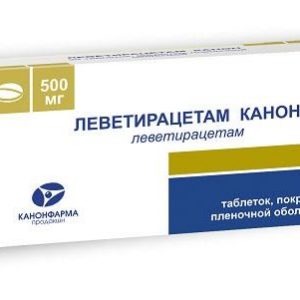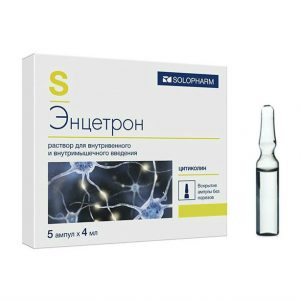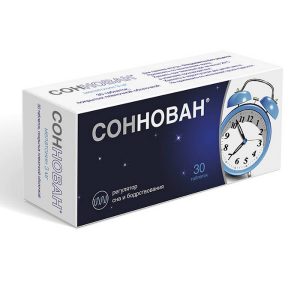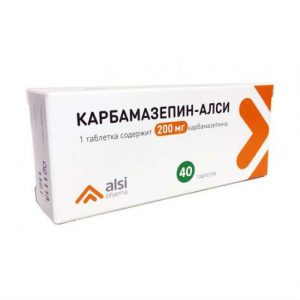Description
Latin name
Memantine
Release form
Film-coated tablets.
Pharmacological action
Dementia treatment.
Pharmacodynamics:
Derived adamantane. It is a non-competitive antagonist of N-methyl-D-aspartate (NMDA) receptors, has a modulating effect on the glutamatergic system. Regulates ion transport, blocks calcium channels, normalizes membrane potential, improves the transmission of nerve impulses. Improves cognitive processes, increases daily activity.
Pharmacokinetics:
Absorption
Eating does not affect absorption. After oral administration, memantine is rapidly and completely absorbed from the gastrointestinal tract. The maximum concentration of memantine in blood plasma is reached after 3-8 hours after administration.
Distribution of
Daily intake of a daily dose of 20 mg leads to an equilibrium plasma concentration of memantine of 70-150 ng / ml. When applying a daily dose of 5-30 mg, the ratio of the average concentration in cerebrospinal fluid to plasma concentration was calculated, equal to 0.52. The volume of distribution is about 10 l / kg. About 45% of memantine binds to plasma proteins. With normal renal function, no cumulation of memantine was noted.
The metabolism of
80% of the circulating memantine in the blood is unchanged. The main metabolites are N-3,5-dimethylgludantane, a mixture of isomers of 4- and 6-hydroxyemantine, 1-nitroso-3,5-dimethyladamantane. Metabolites do not have their own pharmacological activity. In vitro experiments did not reveal a metabolism carried out by cytochrome P450 isoenzymes.
Excretion
Memantine is excreted mainly by the kidneys. Excretion occurs single-phase, the half-life is 60-100 hours. In volunteers with normal renal function, the total clearance is 170 ml / min / 1.73 m2, part of the total renal clearance is achieved due to tubular secretion. Renal excretion also includes tubular reabsorption, possibly mediated by cationic transport proteins. The rate of renal elimination of memantine under conditions of an alkaline reaction of urine can decrease by 7-9 times. Alkalization of urine can be caused by a sharp change in diet, for example, a transition from the diet, including animal products, to a vegetarian diet, or due to the intensive use of alkaline gastric buffers.
Linearity
Studies in volunteers showed linear pharmacokinetics over a dose range of 10 40 mg.
Pharmacokinetic / pharmacodynamic dependence
When applying memantine at a dose of 20 mg / day, the concentration level in the cerebrospinal fluid corresponds to the inhibition constant, which for memantine is 0.5 μmol in the frontal cortex.
Indications
Moderate to severe Alzheimer’s type dementia.
Contraindications
– Hypersensitivity to memantine or any of the components,
components – severe liver failure (Child-Pugh class C)
– lactose intolerance, lactase deficiency,
glucose-galactose malabsorption syndrome –
pregnancy –
breastfeeding period – safety and up to 18 years of age ( not installed).
Caution:
– Thyrotoxicosis
– epilepsy, a predisposition to epilepsy
– convulsions (including a history)
– simultaneous use of NMDA receptor antagonists (amantadine, ketamine, dextromethorphan s ( diets, for example, switching to a vegetarian diet, abundant intake of alkaline gastric buffers)
– renal tubular acidosis
– severe urinary tract infections, caused by bacteria of the genus Proteus
– myocardial infarction (history)
– heart failure (III-IV functional class according to NYHA classification)
– uncontrolled arterial hypertension
– renal failure
– liver failure (class A and B classification) .
Use during pregnancy and lactation
Pregnancy
Use during pregnancy is contraindicated, since there is no data on the effect of memantine on pregnancy.
Experimental studies in animals indicate that intrauterine growth can be slowed if exposure levels are identical or slightly higher than memantine concentrations in humans.
The potential risk to humans is unknown.
Breastfeeding period
There is no information on the release of memantine with breast milk, therefore, women taking memantine should stop breastfeeding.
Special instructions
In patients with an alkaline urine reaction, more careful monitoring of such patients is required due to the slowing down of memantine excretion. Factors causing an increase in urine pH include: dramatic changes in diet, for example, replacing a meat-rich diet with a vegetarian one or intensive use of alkaline gastric buffers. In addition, urine pH may increase due to renal tubular acidosis or severe urinary tract infection caused by bacteria of the genus Proteus.
Data on the use of memantine in patients with a history of myocardial infarction, chronic heart failure (NYHA class III-IV functional class) or uncontrolled arterial hypertension are limited, therefore careful medical monitoring of such patients is necessary.
Use with caution in patients with thyrotoxicosis, epilepsy, seizures (including a history of) and a predisposition to epilepsy.
The simultaneous use of memantine and antagonists of NMDA receptors such as amantadine, ketamine and dextromethorphan should be avoided. These compounds act on the same receptor system as memantine, and therefore adverse reactions (mainly from the central nervous system) can occur more often and be more pronounced.
Memantine contains lactose monohydrate. Patients with hereditary galactose intolerance, lactase deficiency or glucose-galactose malabsorption should not take the drug Memantine.
Impact on the ability to drive transp. Wed and fur .:
In patients with moderate to severe Alzheimer’s type dementia, the ability to drive vehicles and control complex mechanisms is usually impaired. In addition, memantine can cause a change in the reaction rate, so patients need to refrain from driving or working with complex mechanisms.
Composition of
One film-coated tablet contains:
Dosage 10 mg
active substance:
memantine hydrochloride – 10.0 mg
auxiliaries:
microcrystalline cellulose – 152.5 mg srfat 50 mg calcium phosphate croscarmellose sodium
– 12.5 mg
lactose monohydrate -10.0 mg
hyprolysis (hydroxypropyl cellulose) – 5.0 mg trd talc
– 5.0 mg colloidal
silicon dioxide – 2.5 mg magnesium stearate
– 2.5 mg
film coating:
[hypromellose – 4,000 mg, hyprolose (hydroxypropyl cellulose) – 1,5 52 mg, talc – 1.568 mg, titanium dioxide – 0.880 mg] or [dry film coating mixture containing hypromellose (50%), hyprolose (hydroxypropyl cellulose) (19.4%), talc (19.6%), titanium dioxide (11%)] – 8.0 mg.
Dosage and Administration
Memantine therapy should be started and carried out under the supervision of a physician with experience in the diagnosis and treatment of Alzheimer’s type dementia. The diagnosis should be established in accordance with current recommendations.
Treatment should only be started if the person who is constantly caring for the patient regularly monitors the patient for taking the drug.
Tolerance and dosage of memantine should be regularly reviewed, preferably within the first three months after the start of treatment. Following this, the clinical efficacy of memantine and patient tolerance to treatment should be reviewed in accordance with current clinical guidelines.
Maintenance treatment can be continued indefinitely if there is a positive therapeutic effect and good tolerance to the drug.
Memantine should be discontinued in the absence of a positive therapeutic effect or patient intolerance to the drug.
The drug should be taken orally once a day and always at the same time, regardless of the meal.
Recommended starting treatment with memantine is the use of minimally effective doses.
Apply during the 1st week of therapy (days 1-7) at a dose of 5 mg / day, during the 2nd week (days 8-14) at a dose of 10 mg / day, during the 3rd week (days 15 -21) at a dose of 15 mg / day, starting from the 4th week – at a dose of 20 mg / day.
Recommended maintenance dose is 20 mg / day.
The maximum daily dose is 20 mg.
Special patient groups
Elderly patients (over 65)
Dose adjustment is not required.
Patients with impaired renal function
In patients with creatinine clearance of 50-80 ml / min, dose adjustment is not required.
In patients with moderate renal failure (creatinine clearance 30-49 ml / min), the recommended daily dose is 10 mg. With good tolerance of this dose for 7 days, the dose can be increased to 20 mg / day in accordance with the standard scheme.
In patients with severe renal failure (creatinine clearance of 5-29 ml / min), the daily dose should not exceed 10 mg.
Patients with impaired liver function
In patients with impaired liver function of mild to moderate degree (class A and B according to the Child-Pyo classification), dose adjustment is not required.
In patients with severe hepatic insufficiency (class C according to the Child-Pugh classification), the use of the drug is contraindicated.
Side effects
Classification of the incidence of side effects according to the recommendations of the World Health Organization (WHO): very often> 1/10 often from> 1/100 to <1/10 rarely from> 1/1000 to < 1/100 rarely from> 1/10000 to <1/1000 very rarely <1/10000, including individual messages, the frequency is unknown - according to the available data, it is not possible to establish the frequency of occurrence. From the central nervous system: often – headache, dizziness, drowsiness, imbalance infrequently – impaired gait, confusion, hallucinations (hallucinations were observed mainly in patients with severe Alzheimer’s type dementia) very rarely – seizures frequency unknown – psychotic reactions, impaired consciousness, increased irritability, depression, anxiety, suicidal thoughts, increased intracranial pressure, muscle hypertonicity. From the cardiovascular system: often – increased blood pressure infrequently – venous thrombosis / thromboembolism, heart failure. From the digestive system: often – constipation infrequently – nausea, vomiting frequency unknown – pancreatitis, hepatitis. From the respiratory system: is often shortness of breath. From the genitourinary system: frequency is unknown – acute renal failure, cystitis, increased libido. Allergic reactions: often – hypersensitivity to the components of the drug frequency unknown – allergic reactions, Stevens-Johnson syndrome. From the skin: frequency unknown – thrombocytopenic purpura. Laboratory indicators: often – increased activity of liver enzymes frequency unknown – agranulocytosis, leukopenia (including neutropenia), pancytopenia, thrombocytopenia. Other: infrequently – increased fatigue rare – fungal infections, frequency unknown – candidiasis. Drug interaction With the simultaneous use of memantine with levodopa drugs, dopamine receptor agonists, anticholinergics, their effect may be enhanced. With the simultaneous use of memantine with barbiturates, antipsychotics, their effect may be reduced. With the simultaneous use of memantine with dantrolene or baclofen, as well as with antispasmodics, their effect may change (increase or decrease), so the doses of drugs should be selected individually. The simultaneous use of memantine with amantadine should be avoided because of the risk of developing psychosis. Both compounds are antagonists of NMDA receptors. The risk of developing psychosis is also increased with the simultaneous use of memantine with phenytoin, ketamine, and dextromethorphan. With the simultaneous use of memantine with cimetidine, ranitidine, procainamide, quinidine, quinine and nicotine, the risk of increasing the concentration of memantine in the blood plasma increases. With the simultaneous use of memantine with hydrochlorothiazide, a decrease in the concentration of hydrochlorothiazide in blood plasma is possible due to an increase in its excretion from the body. May increase the international normalized ratio (INR) in patients taking concomitant oral indirect anticoagulants (warfarin). It is recommended to regularly monitor prothrombin time or INR in patients taking indirect anticoagulants at the same time. Concurrent use of memantine with antidepressants, selective serotonin reuptake inhibitors and monoamine oxidase inhibitors require close monitoring of patients. According to pharmacokinetic studies, in young healthy volunteers with a single simultaneous administration of memantine with glibenclamide / metformin or donepezil, no drug interaction effects were detected. Clinical studies also did not reveal the effect of memantine on the pharmacokinetics of galantamine in young healthy volunteers. In in vitro studies, memantine did not inhibit CYP 1A2, 2A6, 2C9, 2D6, 2E1, 3A isoenzymes, monooxygenase containing flavin, epoxyhydrolase, and sulfation. With the simultaneous use of memantine with levodopa drugs, dopamine agonists, dopamine agonists anticholinergics their effect may be enhanced. With the simultaneous use of memantine with barbiturates, antipsychotics, their effect may be reduced. With the simultaneous use of memantine with dantrolene or baclofen, as well as with antispasmodics, their effect may change (increase or decrease), so the doses of drugs should be selected individually. The simultaneous use of memantine with amantadine should be avoided because of the risk of developing psychosis. Both compounds are antagonists of NMDA receptors. The risk of developing psychosis is also increased with the simultaneous use of memantine with phenytoin, ketamine, and dextromethorphan. With the simultaneous use of memantine with cimetidine, ranitidine, procainamide, quinidine, quinine and nicotine increases the risk of increasing the concentration of memantine in blood plasma. With the simultaneous use of memantine with hydrochlorothiazide, a decrease in the concentration of hydrochlorothiazide in blood plasma is possible due to an increase in its excretion from the body. May increase the international normalized ratio (INR) in patients taking concomitant oral indirect anticoagulants (warfarin). It is recommended to regularly monitor prothrombin time or INR in patients taking indirect anticoagulants at the same time. The simultaneous use of memantine with antidepressants, selective serotonin reuptake inhibitors and monoamine oxidase inhibitors requires careful monitoring of patients. According to pharmacokinetic studies, in healthy young volunteers with a single simultaneous administration of memantine with glibenclamide / metformin or donepezil, no drug interaction effects were detected. Clinical studies also did not reveal the effect of memantine on the pharmacokinetics of galantamine in young healthy volunteers. In in vitro studies, memantine did not inhibit CYP 1A2, 2A6, 2C9, 2D6, 2E1, 3A isoenzymes, monooxygenase containing flavin, epoxyhydrolase, and sulfation. overdose There is limited data on overdose from clinical trials and post-registration follow-up. symptoms An overdose of relatively high doses of memantine (200 mg once daily, or 105 mg daily for 3 days) is expressed by symptoms of fatigue, weakness and / or diarrhea, or no symptoms. An overdose of up to 140 mg of memantine alone or an unknown amount of memantine is expressed by symptoms associated with the central nervous system (confusion, drowsiness, dizziness, vertigo, anxiety, agitation, hallucinations, gait disturbance) and / or gastrointestinal (gastrointestinal) disorders ). In the most serious cases of overdose, the patient survived after taking more than 2000 mg of memantine with undesirable effects from the nervous system (coma for 10 days, later diplopia, agitation). The patient received symptomatic therapy and plasmapheresis and recovered without consequences. Another reported case of a serious overdose is 400 mg memantine once. The patient recovered without consequences. Undesirable effects from the nervous system were noted: anxiety, psychosis, visual hallucinations, stupor, seizures, drowsiness, unconsciousness. Treatment Symptomatic therapy, gastric lavage, absorbent (activated carbon) intake, urine acidification, forced diuresis (if necessary). There is no specific antidote. Storage conditions Store in a dark place at a temperature not exceeding 25 ° C. Keep out of the reach and sight of children. Shelf life 3 years. Do not use after expiration date. Deystvuyushtee substance Memantine Terms and conditions otpuska IZ drugstore prescription dosage form tablets Possible product names Memantine tablets coated film 10 mg 30 pcs.




